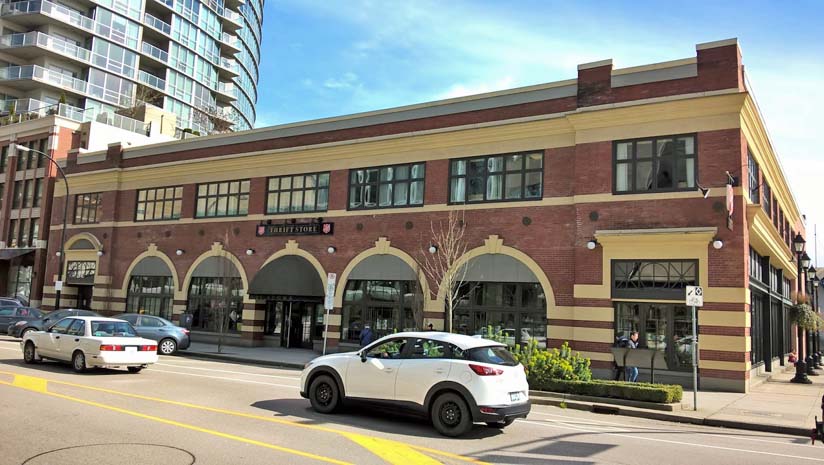


New Westminster British Columbia - New West architect Eric Pattison Architect and The Salvation Army received Heritage BC's highest level of recognition for the rehabilitation of the BC Electric Railway Depot on Columbia Street in New Westminster at the society's annual conference in Langley City on 6 Jun 2008.
The annual awards ceremony recognizes and honours special projects and accomplishments by individuals, organizations, and businesses in the field of Heritage Conservation in B.C.
On 21 Sep 1911 H.R.H. the Duke of Connaught, the Governor General of Canada, welcomed the assembled crowd to the official opening of the British Columbia Electric Railway Depot, the new headquarters for the Interurban line in the city of New Westminster.
Designed by Samuel Maclure, one of the province's most influential early architects, the new station displayed all the quality and hallmarks of an increasingly successful business in the economic and cultural centre of the Fraser Valley, New Westminster. The 2-storey 38,000 square foot masonry and heavy timber building occupied the end of the city block bounded by Columbia, Eighth and Front Streets, the western gateway to the City's downtown. A rare example of a purpose-built train station, the depot included an unusual design feature - the diagonal train concourse running from northwest to southeast through the building. Tall arched windows arcaded along the exterior facades and the diagonal concourse wall, were enhanced by stucco banding, faceted keystones, and curved window muntins. The civic prominence of the station was reflected in the building's impressive character and scale, and high quality of features and materials.
Almost 100 years later, the building sat all but derelict, unrecognizable after years of renovation and neglect. By the mid-50s and the end of Interurban service, the depot's prominence as a major transportation centre had dissipated. The Wosk Brothers purchased the building in 1954 for their appliance store; the first in a long line of commercial uses. They hired Ross Lort Architect, a notable "modern" Vancouver architect, to convert the building into a Modern-style retail business. He removed all historic elements and clad the building in a two-tone rose, stucco finish. The original arched windows were replaced with aluminum storefront glazing and further compromised by large sidewalk canopies. The train concourse was closed and integrated into the building, the ceiling dropped from its original 18 foot height and the diagonal arcade wall mostly removed. Over the next 50 years several renovations followed by various retail tenants.
When the Salvation Army purchased the BCER Depot for a retail store in 2006, a decision was required regarding the fate of the building. Deteriorated timber piles - due to the falling watertable - had caused differential settlement and many materials from past renovations were now at the end of their service life. However, sufficient heritage fabric and historic documentation survived to prompt rehabilitation of the building and careful insertion of a contemporary retail use. The client was able to transfer the depot's unused allowable density to an adjacent property in return for funds to offset facade restoration costs.
The facade was designated the primary character-defining element of the building, the restoration period was established as the inaugural year 1911; the overall project conservation objective was to substantially recall the original depot and re-establish its prominence on Columbia Street. The Heritage Conservation Plan called for the removal of contemporary metal cladding, 1950's stucco, metal windows, storefront and doors, as well as the large sidewalk canopies.
To restore the original massing, reconstruction of the raised roof parapets at the building corners and the prominent feature bays on Columbia Street was required. The original bricks were repaired and repointed; replacement Clayburn bricks were obtained in the original colour. Stucco banding and galvanized metal cornices were reconstructed using affordable expanded foam shapes with a painted stucco finish. Facade lighting matched from historic photos was installed. The windows were reframed to the original layout on both ground and upper floor; however, steel beams now prevented the reconstruction of the arched windows; however stucco panels were used to recall the original design. Modern storefront windows were installed at the original concourse opening along Eighth Street.
The original diagonal train concourse became the primary interior heritage feature as five original brick piers remained and were restored. The remaining diagonal arcade wall was recalled using simple square piers. The original 18 foot ceiling height re-established.
Once facade restoration began practical considerations came forward. Along Columbia Street and most of Eighth, the 1954 stucco easily detached from the original brick due to the damp environment. However, along the dry southern exposure stucco removal proved too damaging to the brick. The solution was to acknowledge a second Restoration Period of 1954, the height of business and urbanism along "The Golden Mile" that was Columbia Street at the time. Stucco restoration along Front Street and part of Eighth proceeded, rediscovering and celebrating Ross Lort's original modernist design intent.
By returning a building of such notable business and architectural pedigree to a high degree of prominence and respectability civic identity is strengthened, street character improved, and future heritage conservation work encouraged. The BCER Depot is a major piece of local history for New Westminster and the city's role in the development of the region. The depot recalls the glory of past grand buildings by great architects and contributes once more to the historic character of the area and the economic activity of the downtown. Honoring the BCER Depot with a Heritage Award recognizes a city eager to support the revitalization and protection of its historic buildings, a client mindful of the entire lifespan of the buildings they occupy and the promotion of heritage preservation, and a design team sensitive to the existing conditions within which they work as well as ultimate goals of restoration.
Author unknown.